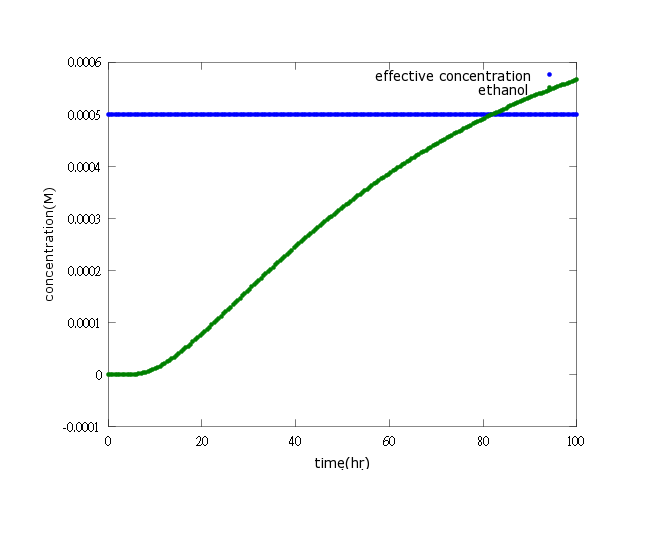Team:NYMU-Taipei/Modeling/Ethanol/explanation
From 2013.igem.org
(Created page with "{{:Team:NYMU-Taipei/Header}} ==Explanation:== <html> <div lang="latex" class="equation"> \frac{d[mRNAT7]}{dt}=\frac{ [ROSoxyR]^{nROSoxyR} }{ KdROSoxyR^{nROSoxyR}+[ROSoxyR]^{nROS...") |
|||
| Line 69: | Line 69: | ||
[[File:NYMU_123 cycle.jpg]] | [[File:NYMU_123 cycle.jpg]] | ||
| - | + | ||
| - | + | ||
| - | + | ||
| - | + | ||
| - | + | ||
| - | + | ||
| - | + | ||
| - | + | ||
| - | + | ||
| - | + | ||
| - | + | ||
| - | + | ||
| - | + | ||
{{:Team:NYMU-Taipei/Footer}} | {{:Team:NYMU-Taipei/Footer}} | ||
Revision as of 14:08, 27 October 2013


Explanation:
PoPS represents the promoter strength which is measured by the rate of RNApolymerase binding to the starting site of DNA transcription; \frac{ [molecule]^{nmolecule} }{ Kdmolecule^{nmolecule}+[molecule]^{nmolecule} } represents the hill effect of transcription factors (either activators or repressors) to the promoter.
In this equation, the production rate of mRNAT7 is composed of both synthesizing rate and degrading rate. \frac{ [ROSoxyR]^{nROSoxyR} }{ KdROSoxyR^{nROSoxyR}+[ROSoxyR]^{nROSoxyR} }\times{PoPStrxC}\times\frac{N}{V}\times{a} represents how activator ROSoxyR influences promoter trxC on synthesizing mRNAT7 and how thresholds behind the promoter blocks the synthesis of mRNAT7 (the possibility of RNA polymerase to skip thresholds right after trxC promoter is shown in probability);\frac{ [T7]^{nT7} }{ KdT7^{nT7}+[T7]^{nY7} }\times{PoPST7}\times\frac{N}{V}represents how T7 polymerase influences promoter T7 on synthesizing mRNAT7; -KdegmRNA\times[mRNAT7] represents the natural degrading rate of mRNAT7.
In this equation, the production rate of T7 polymerase is composed of both synthesizing rate and degrading rate. RBS represents ribosome binding site strength, which is the affinity of ribosome to the starting site of mRNA; PoPS represents the promoter strength and \frac{[molecule]^{nmolecule}}{ Kdmolecule^{nmolecule}+[molecule]^{nmolecule} }, as mentioned above, represents the hill effect of transcription factors to the promoter.
For the section of the equation,\RBS\times{PoPStrxC}\times\frac{N}{V}\times{a}\times{\frac{ [ROSoxyR]^{n1} }{ [Kd]^{n1}+[ROSoxyR]^{n1} }}} represents the synthesizing rate of T7 polymerase under the influence of activator ROSoxyR complex, promoter trxC and terminators downstream; \PoPST7\times{T7 effect}\times\frac{N}{V}, similarly, represents the synthesizing rate of T7polymerase under the influence of T7promoter; \-{KdegT7}\times{T7}represents the natural degrading rate of T7 polymerase.
In these two equations, the production rate of mRNAPDC and mRNAADH is composed of both synthesizing rate and degrading rate. \frac{ [T7]^{nT7} }{ KdT7^{nT7}+[T7]^{nY7} }\times{PoPST7}\times\frac{N}{V} represents how T7 polymerase influences promoter T7 on synthesizing mRNAPDC and mRNAADH;\frac{ [T7]^{nT7} }{ KdT7^{nT7}+[T7]^{nY7} } and\frac{ [T7]^{nT7} }{ KdT7^{nT7}+[T7]^{nY7} } represents the natural degrading rate of mRNAPDC and [mRNAADH].
In these two equations, the production rate of PDC and ADH is composed of both synthesizing rate and degrading rate. RBS represents ribosome binding site strength, which is the affinity of ribosome to the starting site of mRNA; PoPST7 represents the promoter strength of T7 promoter.
For the section of the equation, RBS ×PoPS"T7effect ×N/V" represents the synthesizing rate of PDC and ADH under the influence of T7promoter; "- KdegPDC ×[PDC]" and" - KdegADH ×[ADH]" represents the natural degrading rate of PDC and ADH.
In this equation, the production rate of ethanol is composed of both synthesizing rate and degrading rate. Kpyruvateacetaldehyde represents reaction rate constant of pyruvate→acetaldehyde, while Kacetaldehydeethanol represents reaction rate constant of acetaldehyde→ethanol; \frac{ [PDC]^{nPDC} }{ KdPDC^{PDC}+[PDC]^{PDC} }represents hill effect of PDC to pyruvate→acetaldehyde reaction, while \frac{ [ADH^{nADH} }{ KdADH^{ADH}+[ADH]^{ADH} }represents hill effect of ADH to acetaldehyde→ethanol reaction; Km represents the rate constant of ethanol→acetaldehyde, a reverse reaction of the second process of ethanol synthesis. For the section of the equation, \times{ Kpyruvateacetaldehyde }{ Kacetaldehydeethanol }\frac{ [PDC]^{nPDC} }{ KdPDC^{PDC}+[PDC]^{PDC} }{ [ADH^{nADH} }{ KdADH^{ADH}+[ADH]^{ADH} } represents the synthesizing rate of ethanol from pyruvate to acetaldehyde to ethanol under the influence of enzymes ADH and PDC; \times{ -Km }{ Kacetaldehydeethanol }{ [ADH^{nADH} }{ KdADH^{ADH}+[ADH]^{ADH} }{[ethanol]} takes the reverse reaction of acetaldehyde to ethanol into consideration, which results in the decreasing of ethanol.
The code of ethanol production:

 "
"








